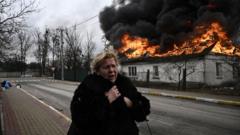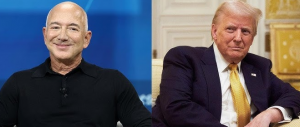Escalating Tensions: 1000 Days of War in Ukraine and Shifting Power Dynamics

Escalating Tensions: 1000 Days of War in Ukraine and Shifting Power Dynamics
The Ukraine-Russia conflict marks its 1000th day, seeing heightened military actions from both sides amidst changes in nuclear strategy and geopolitical maneuvering.
Summary: As the Ukraine war hits its 1000th day, Western support for Ukraine intensifies with new arms approvals, while Russia escalates its nuclear posturing. The impending U.S. presidential transition adds further uncertainty to the conflict dynamics.
In a week marking the 1000th day of the Ukraine-Russia war, the stakes escalated dramatically as Western nations elevated military assistance to Ukraine while Russia intensified its nuclear threats. This week's events not only reflected the ongoing intensity of the conflict but also anticipated shifts in global geopolitical dynamics.
Late on Sunday, a major policy shift occurred when U.S. President Joe Biden authorized Ukraine to deploy longer-range ATACMS missiles capable of striking targets within Russia. This decision, which reversed earlier restrictions on missile use beyond Ukraine's borders, was followed by Ukrainian strikes into Russia's Bryansk region. The scale of these actions was clarified amidst conflicting reports from the Kremlin and U.S. officials, marking a significant escalation in Ukraine’s operational capabilities against Russian assets.
On Wednesday, Ukrainian forces further expanded their offensive capabilities by employing UK-supplied Storm Shadow missiles against targets in Russia's Kursk region. This strategic targeting followed Ukraine's military gains in the area. The week concluded with Biden approving the use of anti-personnel landmines to bolster Ukraine's defenses, underscoring a robust and united Western commitment to Ukraine's sovereignty.
In response to Western military support, Russia raised the stakes through significant changes to its nuclear doctrine, publicly altering its stance on the use of nuclear weapons. President Vladimir Putin proclaimed that attacks from non-nuclear states backed by nuclear powers would be regarded as joint aggressions. Further amplifying these threats, Russia launched the "Oreshnik," a new missile claimed to travel at ten times the speed of sound, at the city of Dnipro. This display of military capability was interpreted as a sobering signal of Russia’s readiness to resort to nuclear escalation.
As both sides intensified military rhetoric, the strategic roles of other nations, particularly China and North Korea, became apparent. China has emerged as a critical ally for Russia amid Western sanctions, and recent declarations from North Korean leader Kim Jong Un added another layer to the already complex conflict landscape. He warned of an unprecedented nuclear threat tied to U.S. policy.
The timing of these developments aligns with an anticipated transition in U.S. leadership, as President-elect Donald Trump prepares to assume office. During his campaign, Trump suggested a willingness to negotiate the war's resolution swiftly, potentially redefining the nature of Western support for Ukraine. Some observers speculate that Trump’s presidency might lead to a realignment of priorities concerning territorial concessions in Eastern Ukraine, contrasting sharply with the Biden administration's military aid strategy.
While there is apprehension regarding potential escalations from the ongoing conflict, analysts suggest that current developments may signal a competition for leverage in future negotiations rather than an outright escalation towards wider warfare. The question now looms: how will these shifts affect the war’s trajectory and the delicate balance of international relations?
In a week marking the 1000th day of the Ukraine-Russia war, the stakes escalated dramatically as Western nations elevated military assistance to Ukraine while Russia intensified its nuclear threats. This week's events not only reflected the ongoing intensity of the conflict but also anticipated shifts in global geopolitical dynamics.
Late on Sunday, a major policy shift occurred when U.S. President Joe Biden authorized Ukraine to deploy longer-range ATACMS missiles capable of striking targets within Russia. This decision, which reversed earlier restrictions on missile use beyond Ukraine's borders, was followed by Ukrainian strikes into Russia's Bryansk region. The scale of these actions was clarified amidst conflicting reports from the Kremlin and U.S. officials, marking a significant escalation in Ukraine’s operational capabilities against Russian assets.
On Wednesday, Ukrainian forces further expanded their offensive capabilities by employing UK-supplied Storm Shadow missiles against targets in Russia's Kursk region. This strategic targeting followed Ukraine's military gains in the area. The week concluded with Biden approving the use of anti-personnel landmines to bolster Ukraine's defenses, underscoring a robust and united Western commitment to Ukraine's sovereignty.
In response to Western military support, Russia raised the stakes through significant changes to its nuclear doctrine, publicly altering its stance on the use of nuclear weapons. President Vladimir Putin proclaimed that attacks from non-nuclear states backed by nuclear powers would be regarded as joint aggressions. Further amplifying these threats, Russia launched the "Oreshnik," a new missile claimed to travel at ten times the speed of sound, at the city of Dnipro. This display of military capability was interpreted as a sobering signal of Russia’s readiness to resort to nuclear escalation.
As both sides intensified military rhetoric, the strategic roles of other nations, particularly China and North Korea, became apparent. China has emerged as a critical ally for Russia amid Western sanctions, and recent declarations from North Korean leader Kim Jong Un added another layer to the already complex conflict landscape. He warned of an unprecedented nuclear threat tied to U.S. policy.
The timing of these developments aligns with an anticipated transition in U.S. leadership, as President-elect Donald Trump prepares to assume office. During his campaign, Trump suggested a willingness to negotiate the war's resolution swiftly, potentially redefining the nature of Western support for Ukraine. Some observers speculate that Trump’s presidency might lead to a realignment of priorities concerning territorial concessions in Eastern Ukraine, contrasting sharply with the Biden administration's military aid strategy.
While there is apprehension regarding potential escalations from the ongoing conflict, analysts suggest that current developments may signal a competition for leverage in future negotiations rather than an outright escalation towards wider warfare. The question now looms: how will these shifts affect the war’s trajectory and the delicate balance of international relations?




















